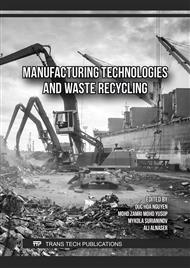[1]
A. M. Khorasani, M. Goldberg, E. H. Doeven, and G. Littlefair, Titanium in Biomedical Applications – Properties and Fabrication: A Review. J. Biomater. Tissue Eng., 5 (2015) 593.
DOI: 10.1166/jbt.2015.1361
Google Scholar
[2]
I.A.B. Neta, M. F. Mota, H.L. Lira, G. A. Neves and R.R. Menezes: Nanostructured titanium dioxide for use in bone implants: a short review, Cerâmica 66 (2020) 440.
DOI: 10.1590/0366-69132020663802905
Google Scholar
[3]
M. Textor, C. Sittig, V. Frauchiger, S. Tosatti and D. M. Brunette, Properties and Biological Significance of Natural Oxide Films on Titanium and Its Alloys. Springer-Verlag Berlin Heidelberg. 7 (2021) 171.
DOI: 10.1007/978-3-642-56486-4_7
Google Scholar
[4]
K. Indira, U. K. Mudali, T. Nishimura and N. Rajendran, A Review on TiO2 Nanotubes: Influence of Anodization Parameters, Formation Mechanism, Properties, Corrosion Behavior, and Biomedical Applications, J Bio Tribo Corros, 1(2015) 1-28.
DOI: 10.1007/s40735-015-0024-x
Google Scholar
[5]
Z. Li, J. Pan, H. Bian, J. Lu and Y.Y. Li, New explanation on formation mechanism of anodic TiO2 nanotubes, J. mater. sci. eng., B, 286 (2022) 115985.
DOI: 10.1016/j.mseb.2022.115985
Google Scholar
[6]
L.V. Toan, T.Q. Tuan, P.H. Vuong, Effect of current density on the morphology and electrochemical properties of nanotubular TiO2 for implant applications, Material Research Express, 11 (2024) 065404-065416.
DOI: 10.1088/2053-1591/ad5643
Google Scholar
[7]
T.Q. Tuan, L.V. Toan, P.H. Vuong, Synthesis of Heterostructured TiO2 Nanopores/Nanotubes by Anodizing at High Voltages, Materials MPDI. 17 (2024) 3347–3354.
DOI: 10.3390/ma17133347
Google Scholar
[8]
A. Krzakała, K. Słuzalska, G. Derczc, A. Macieja, A. Kazek, J. Szade, A. Winiarskid, M. Dudeke, J. Michalskaf, G. Tylko, A. M. Osyczkab, W. Simka, Characterisation of bioactive films on Ti–6Al–4V alloy. Electrochimica Acta 104 (2013) 425-439.
DOI: 10.1016/j.electacta.2012.12.081
Google Scholar
[9]
K. Gulati, S. Ramakrishnan, M. Sinn Aw, G. J. Atkins, D. M. Findlay, D. Losic: Biocompatible polymer coating of titania nanotube arrays for improved drug elution and osteoblast adhesion. Acta Biomaterialia 8 (2012) 449.
DOI: 10.1016/j.actbio.2011.09.004
Google Scholar
[10]
J.W.J. Hamilton, J.A. Byrne, C. McCullagh and P.S.M. Dunlop, Electrochemical Investigation of Doped Titanium Dioxide. Int. J. Photoenergy. 1 (2008) 1.
DOI: 10.1155/2008/631597
Google Scholar
[11]
H. Yu, J. Chen, S. Zhang, Y. Yu, S. Wang and M. Ye, Effects of electrolyte composition on the growth and properties of titanium oxide nanotubes. Electrochem. Commun. 135 (2022) 107217.
DOI: 10.1016/j.elecom.2022.107217
Google Scholar
[12]
Y. Zhang, C. Dong, S. Yan, T. Chiu, J. Wu, K. Xiao, Y. Huang and X. Li, Enhanced silver loaded antibacterial titanium implant coating with novel hierarchical effect, J. Biomater. Appl., 0(0) (2018) 1-11.
DOI: 10.1177/0885328218755538
Google Scholar
[13]
L. Ge, Q. Li, M. Wang, J. Ouyang, X. Li, M. MQ. Xing, Nanosilver particles in medical applications: synthesis, performance, and toxicity, International Journal of Nanomedicine Dovepress, 9 (2014) 2399 - 2407.
DOI: 10.2147/ijn.s55015
Google Scholar
[14]
T. Yetim, Corrosion Behavior of Ag-doped TiO2 Coatings on Commercially Pure Titanium in Simulated Body Fluid Solution, J. Bionic Eng., 13 (2016) 398 – 405.
DOI: 10.1016/s1672-6529(16)60311-6
Google Scholar
[15]
S. Demircia, T. Dikicib, M. Yurddaskal, S. Gultekind, M. Toparli, E. Celik, Synthesis and characterization of Ag doped TiO2 heterojunction films and their photocatalytic performances, Applied Surface Science 390 (2016) 591–601.
DOI: 10.1016/j.apsusc.2016.08.145
Google Scholar
[16]
P. Singh, S. Singh, B. Maddiboyina, S. Kandalam, T. Walski, R. A. Bohara, Hybrid silver nanoparticles: Modes of synthesis and various biomedical applications, Electron. 22(2024)1-23
DOI: 10.1002/elt2.22
Google Scholar
[17]
I.J. Ferrer, J.R. Ares, J.M. Clamagirand, M. Barawi, C. Sánchez, Optical properties of titanium trisulphide (TiS3) thin films, Thin Solid Films, 535 ( 2013) 398-401.
DOI: 10.1016/j.tsf.2012.10.033
Google Scholar
[18]
H. Xu, G. Li, G. Zhu, K. Zhu, S. Jin, Enhanced photocatalytic degradation of rutile/anatase TiO2 heterojunction nanoflowers, Catal. Commun, 62 (2015) 52-56.
DOI: 10.1016/j.catcom.2015.01.001
Google Scholar
[19]
J. Xu, J. Hu, C. Peng, H. Liu, Y. Hu, A simple approach to the synthesis of silver nanowires by hydrothermal process in the presence of gemini surfactant, Journal of Colloid and Interface Science, 298 (2006) 689-693.
DOI: 10.1016/j.jcis.2005.12.047
Google Scholar
[20]
A. Campero and J. A. D. Ponce, Relationship between the Atomic Structure and Electrochemistry. 1.Electric Force, Standard Reduction Potential E°, and StandardReaction Gibbs Free Energy ΔG°, ACS Omega, 5 (2020) 11874-12582.
DOI: 10.1021/acsomega.0c00257
Google Scholar



